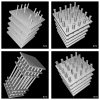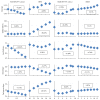A Digital Model to Simulate Effects of Bone Architecture Variations on Texture at Spatial Resolutions of CT, HR-pQCT, and μCT Scanners
- PMID: 27006936
- PMCID: PMC4782631
- DOI: 10.1155/2014/946574
A Digital Model to Simulate Effects of Bone Architecture Variations on Texture at Spatial Resolutions of CT, HR-pQCT, and μCT Scanners
Abstract
The quantification of changes in the trabecular bone structure induced by musculoskeletal diseases like osteoarthritis, osteoporosis, rheumatoid arthritis, and others by means of a texture analysis is a valuable tool which is expected to improve the diagnosis and monitoring of a disease. The reaction of texture parameters on different alterations in the architecture of the fine trabecular network and inherent imaging factors such as spatial resolution or image noise has to be understood in detail to ensure an accurate and reliable determination of the current bone state. Therefore, a digital model for the quantitative analysis of cancellous bone structures was developed. Five parameters were used for texture analysis: entropy, global and local inhomogeneity, local anisotropy, and variogram slope. Various generic structural changes of cancellous bone were simulated for different spatial resolutions. Additionally, the dependence of the texture parameters on tissue mineralization and noise was investigated. The present work explains changes in texture parameter outcomes based on structural changes originating from structure modifications and reveals that a texture analysis could provide useful information for a trabecular bone analysis even at resolutions below the dimensions of single trabeculae.
Figures








Similar articles
-
Advanced Knee Structure Analysis (AKSA): a comparison of bone mineral density and trabecular texture measurements using computed tomography and high-resolution peripheral quantitative computed tomography of human knee cadavers.Arthritis Res Ther. 2017 Jan 10;19(1):1. doi: 10.1186/s13075-016-1210-z. Arthritis Res Ther. 2017. PMID: 28073368 Free PMC article.
-
Characterization of knee osteoarthritis-related changes in trabecular bone using texture parameters at various levels of spatial resolution-a simulation study.Bonekey Rep. 2014 Dec 3;3:615. doi: 10.1038/bonekey.2014.110. eCollection 2014. Bonekey Rep. 2014. PMID: 25512855 Free PMC article.
-
Determination of vertebral and femoral trabecular morphology and stiffness using a flat-panel C-arm-based CT approach.Bone. 2012 Jan;50(1):200-8. doi: 10.1016/j.bone.2011.10.020. Epub 2011 Oct 26. Bone. 2012. PMID: 22057082
-
Assessment of trabecular structure using high resolution magnetic resonance imaging.Stud Health Technol Inform. 1997;40:81-96. Stud Health Technol Inform. 1997. PMID: 10168884 Review.
-
[Computer-assisted structure analysis of trabecular bone in the diagnosis of osteoporosis].Radiologe. 1998 Oct;38(10):853-9. doi: 10.1007/s001170050434. Radiologe. 1998. PMID: 9830666 Review. German.
Cited by
-
Advanced Knee Structure Analysis (AKSA): a comparison of bone mineral density and trabecular texture measurements using computed tomography and high-resolution peripheral quantitative computed tomography of human knee cadavers.Arthritis Res Ther. 2017 Jan 10;19(1):1. doi: 10.1186/s13075-016-1210-z. Arthritis Res Ther. 2017. PMID: 28073368 Free PMC article.
-
Characterization of knee osteoarthritis-related changes in trabecular bone using texture parameters at various levels of spatial resolution-a simulation study.Bonekey Rep. 2014 Dec 3;3:615. doi: 10.1038/bonekey.2014.110. eCollection 2014. Bonekey Rep. 2014. PMID: 25512855 Free PMC article.
References
-
- Pialat J., Burghardt A. J., Sode M., Link T. M., Majumdar S. Visual grading of motion induced image degradation in high resolution peripheral computed tomography: impact of image quality on measures of bone density and micro-architecture. Bone. 2012;50(1):111–118. doi: 10.1016/j.bone.2011.10.003. - DOI - PubMed
LinkOut - more resources
Full Text Sources
Other Literature Sources
